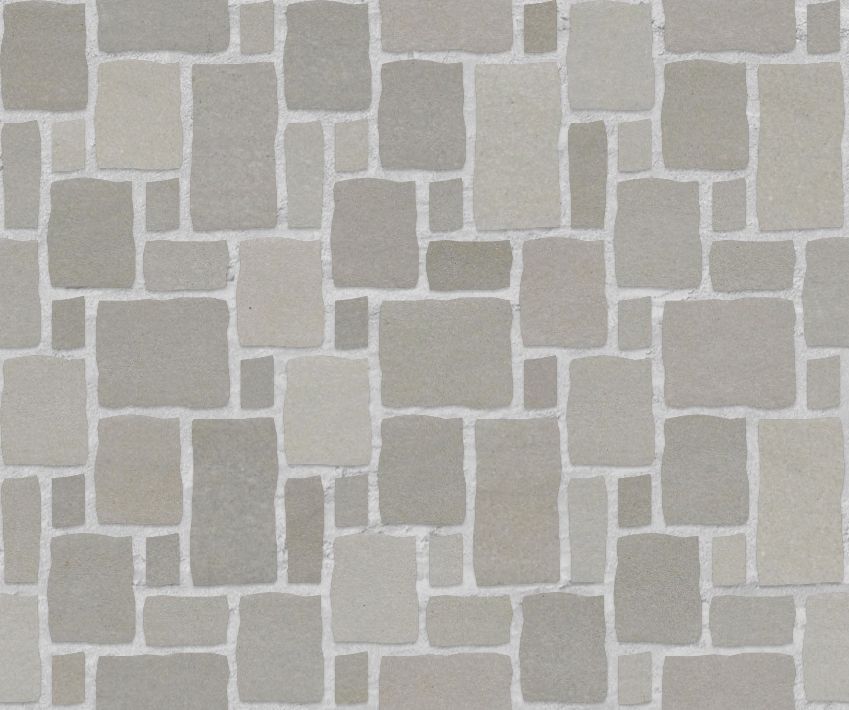Buff Porcelain Brick French Pattern
Category
Brick
Download
Edit
A light grey-cream buff, smooth textured Flemish Bond porcelain facing brick with a wide, flush, rough, buff concrete mortar for interior uses. Porcelain bricks are a less common variety of masonry material due to their lower robustness in comparison with clay or concrete masonry, making them more specifically suited to indoor environments or mellow climates.
Porcelain bricks are a less common variety of masonry material due to their lower robustness in comparison with clay or concrete masonry, making them more specifically suited to indoor environments or mellow climates.
This particular brick type is desirable for use on interior wall finishes due to its smooth, neutral and bright characteristics. Light coloured porcelain bricks such as this are most commonly found in deep plan spaces, stairwells, corridors and light-wells as they reflect light deeper into the spaces in which they are specified. They are often used in the composition of spaces where the desire is to create a brighter, airier, ethereal, more open and spacious appearance in a room, or as a neutral offset in combination with natural materials such as metal, timber, stone or in soft landscaped areas, while the human scale of the standard sized brick is well suited to domestic environments. Porcelain bricks have a cool haptic quality, with a smoother, softer texture than clay or concrete bricks and blockwork.
Bricks are one of the most common materials in architecture and construction. With recorded uses dating back over 9000 years, brick traces its origins to mud and straw adobe blocks as found in Africa, southern Asian and southern American regions where hot, dry climates quickly dried and cured the earth bricks naturally in the heat. Clay bricks were used extensively throughout the Roman Empire thanks to the Romans’ invention of the mobile kiln, an innovation on the kiln used by ancient Egyptian builders to fire clay mixtures when placed in moulds, which enabled brick manufacture across Rome’s territories, using an increased range of local clay and soil compositions. Bricks were then regularly used in Europe from around the 12th century, when northern European countries traded materials, knowledge and design ideologies with Italy during the Gothic and Renaissance eras, spreading the use of Roman designs and construction methods, until dying out for a period due to bricks’ inability to recreate the intricate shapes of ornament and decoration associated with these styles.
The exploration of new forms and manufacturing methods seen a return to popularity, combined with their increasingly popular reputation as a replacement to timber in densely populated cities in the 17th century, particularly London, due to their far superior fire retarding properties, following a spate of particularly serious, destructive urban fires that ripped through older timber building stock. Other cities followed suit during the 18th century industrial revolution as bricks proved a hardy, enduring, cost effective, simple to construct, reliable, impervious, consistently dimensioned building unit protecting against damp air and wet ground conditions, especially after the invention of fast, mass manufacturing techniques. Brick was then popularised in northern America and other English, Belgian, Dutch, French, Spanish and Portuguese territories, through early émigrés taking their masonry skills abroad.
They remain popular due to their readily available raw materials, simple manufacture, low cost, ease of maintenance, basic-skilled assembly and attractive variety of colours, textures and finishes. Modern brick can be cut to standard sizes to form a versatile, durable building product, or specially manufactured to suit a variety of angles, curves and unique shapes for decorative purposes on organic forms. Hard-wearing and with excellent structural and thermal properties, they are a popular, efficient, human-scaled material for paving, load-bearing walls, cladding systems, landscaping and interior decorative walls, while a variety of finishes and palettes within the one product can create rustic, weathered, industrial aesthetics increasingly popular in bespoke, contemporary domestic, hospitality and workplace environments; practical, perfunctory settings; or decorative façades. Preferred for their domestic, human scale, bricks are one of the easiest construction materials to handle and build with when combined and laid with cementitious mortars. They are well suited to domestic, care, primary education and community building types in all climatic settings provided they are manufactured correctly and to the right specifications with respect to their locale.
This texture uses a Flemish pattern, which comes from the Flemish Bond used in brick construction. The Flemish Bond alternates between stretchers which are full width units, and headers which are half width units, along each row. The headers in each course are centred on the stretchers below. The flush mortar is thicker than on typical masonry construction, using a neutral toned, rough, buff mortar, contrasting the smooth texture of the brick, meaning this texture is more suitable for use in non load-bearing, interior wall finishes.
A seamless brick texture with buff porcelain brick arranged in a french pattern. Seamless textures can be tiled repeatedly across a surface without visible seams making them useful for architectural drawings and 3D models. This image can be used as a SketchUp texture, Revit material or imported into Photoshop for use in 2D illustrations. A high resolution version of this texture is available, as well as CAD hatches and PBR maps with Architextures Pro.

